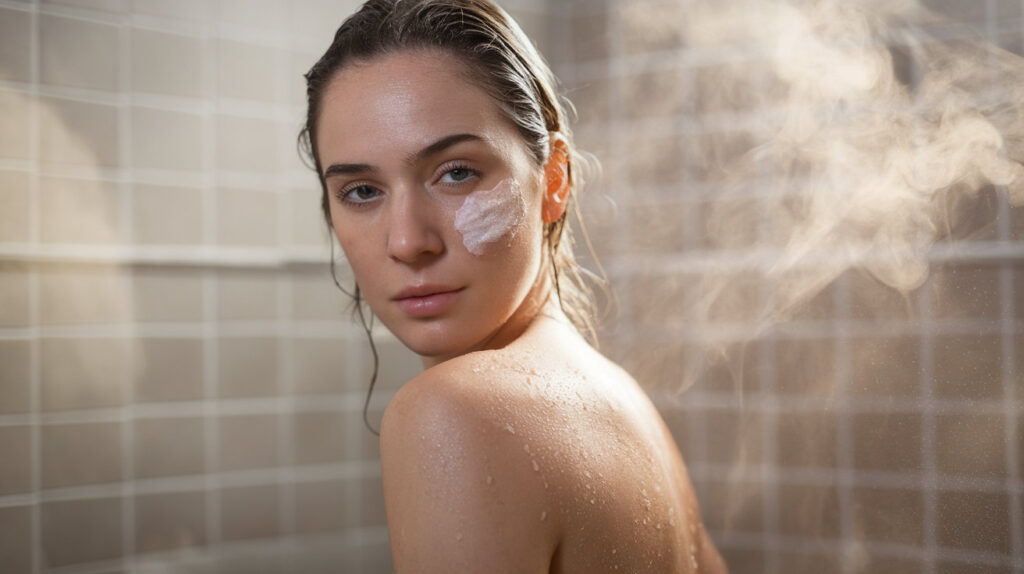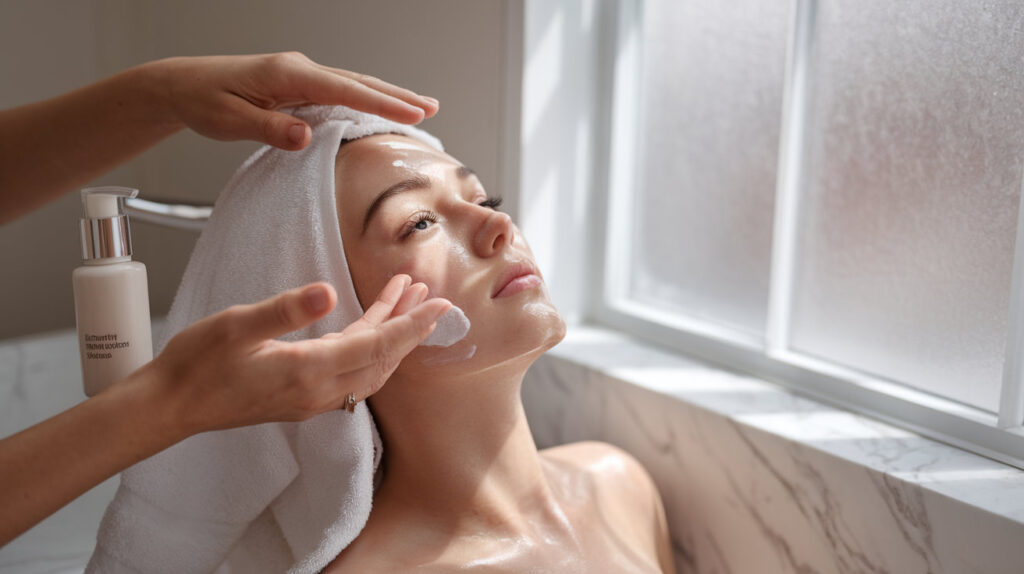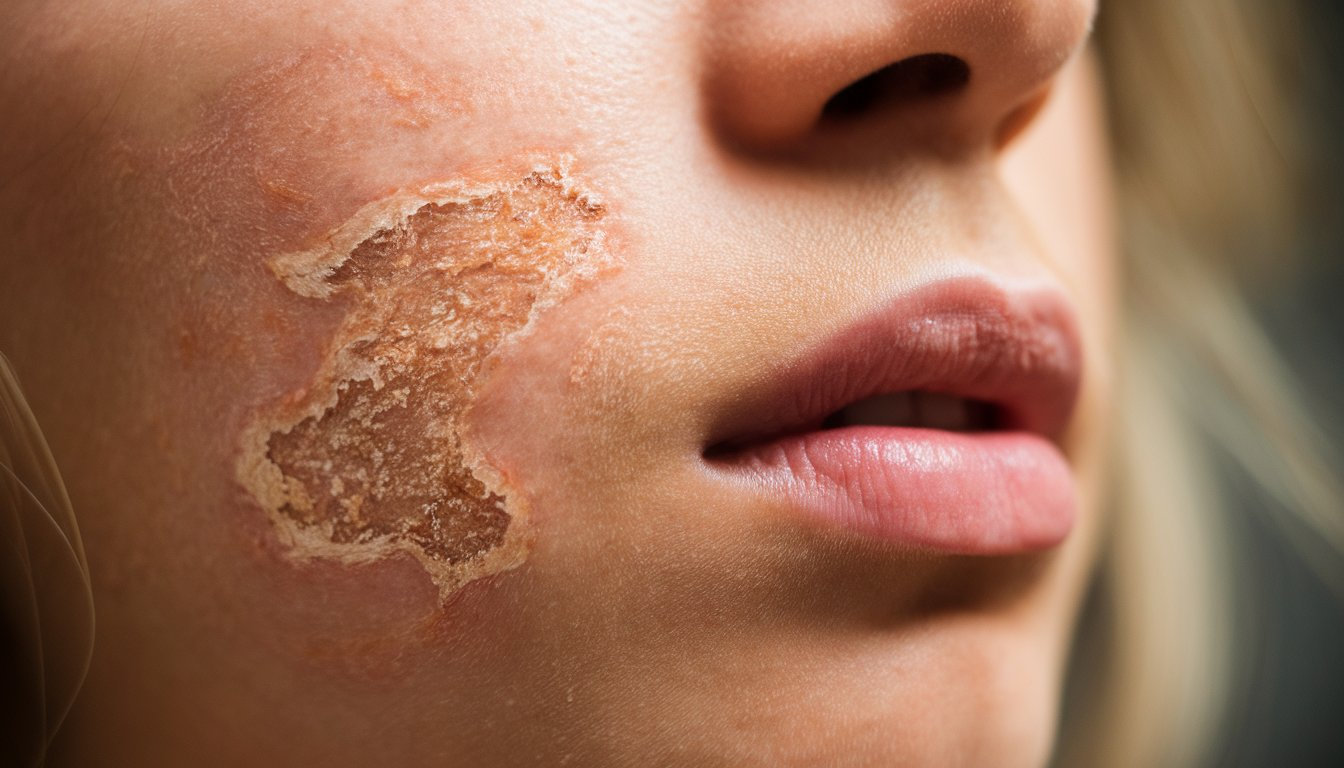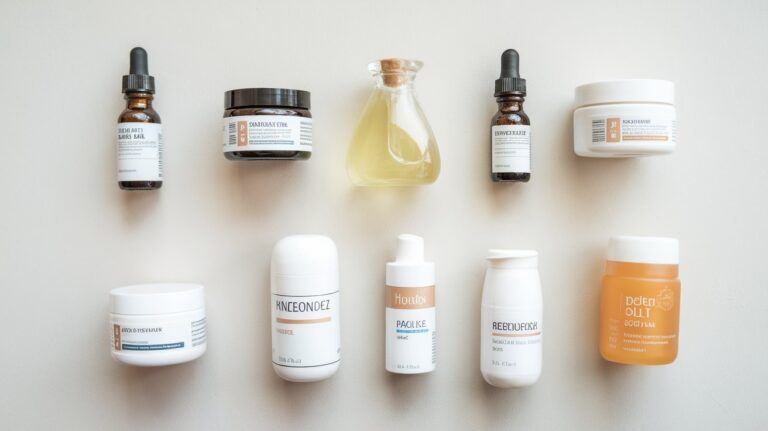Ever stepped out of a steamy bathroom to find flaky patches on your face? This common problem affects many, causing discomfort and low self-confidence. I’ve fought this issue for years, researching and trying different solutions.

The reason behind facial peeling often lies in a damaged skin barrier. This barrier keeps moisture in and irritants out. Several common causes include water temperature, harsh cleansers, skin conditions, and environmental factors.
But there’s good news. You don’t need expensive treatments or complicated routines to fix this. I’ve found five quick fixes that help both immediately and prevent dry skin in the long run. These solutions restore your skin’s natural balance and tackle the causes of facial peeling.
Key Takeaways
- Hot showers can damage your skin barrier, leading to facial peeling
- Underlying skin conditions often manifest as post-shower peeling
- Proper hydration both internally and externally helps prevent dry skin
- Gentle cleansers preserve your skin’s natural protective oils
- Environmental factors like humidity and temperature affect facial moisture levels
- Simple at-home remedies can provide immediate relief from peeling
The Science Behind Facial Skin Peeling
Ever wondered why your face feels tight and peels after a shower? It’s all about skin science. Knowing how your skin works and what happens in the shower can stop that flaking.
How Your Skin’s Natural Barrier Works
Your skin’s outer layer, the stratum corneum, is like a brick wall. Dead skin cells are the bricks, and natural oils are the mortar. This keeps everything together.
This skin barrier does two main things: it keeps moisture in and keeps out irritants. When it’s working right, your skin feels smooth and comfortable. The lipids between cells help keep water in the layer of your skin.
What Happens to Skin Cells During and After Showering
Hot showers strip away the lipids that hold your skin cells together. Without these lipids, your barrier weakens. This lets moisture escape quickly when you get out.
This fast water loss makes your skin feel tight. When your skin’s moisture drops, dead skin cells start to flake and peel. This is because they’re not shedding naturally.
Normal skin cell turnover is 28 days. But harsh showering can disrupt this, causing damaged skin and uneven skin texture. Knowing this helps you shower better to protect your skin.
Why Does My Skin Peel on My Face After Shower?
Wondering why your face peels after showering? It’s often due to common culprits that upset your skin’s balance. Knowing these can help you tackle your skin issues. Let’s look at the main reasons your face might peel after washing or showering.
Hot Water Strips Natural Oils
Water temperature is a big reason for peeling skin. Taking showers above 105°F removes your skin’s protective layer. Hot showers strip your skin of its natural oils (sebum) that keep it safe.
This sebum layer is key for keeping moisture in. Without it, water quickly leaves your skin, causing dryness and flaking. Even though hot showers might feel good, they harm your skin barrier, leading to peeling.
Harsh Cleansers Damage the Skin Barrier
Many facial cleansers can cause peeling, especially after a shower. Antibacterial soaps, deodorant soaps, and alcohol-based products are especially bad.
These harsh cleansers have sulfates and high pH levels that mess with your skin’s acid mantle. This messes up your lipid barrier, causing irritation and peeling. For those wearing makeup, trying to hide peeling skin can irritate it more.
Over-Exfoliation and Scrubbing
Scrubbing too hard or using exfoliants too often can make your skin peel. Physical scrubs can tear your skin, while chemical exfoliants can remove too many cells if used too much.
This over-exfoliation makes your skin raw and open to damage. It disrupts your skin’s natural renewal, causing uneven shedding and peeling. Your face needs gentle care, especially when it’s wet and more prone to harm.
Hard Water Effects on Facial Skin
Hard water might also be causing your peeling skin. It has high levels of minerals like calcium and magnesium that can leave deposits on your skin after washing.
These deposits can dry out your skin by preventing moisture absorption. Hard water also makes it hard for soaps and cleansers to rinse away completely, leaving residue that irritates and peels your skin.
Figuring out which of these factors is causing your dry skin is the first step to solving the problem. Often, it’s a mix of factors that lead to peeling, so you’ll need a comprehensive approach to fix your skin’s health and comfort.
Common Skin Conditions That Worsen After Showering
Many skin conditions can get worse after showering. These include eczema, psoriasis, and sunburn. They can make your skin flake and peel more easily. Knowing about these conditions can help you take better care of your skin after showering.
Eczema and Contact Dermatitis
Eczema makes your skin more sensitive to water. Hot water can strip away what little protection your skin has. This leads to intense itching and redness right after showering.
Contact dermatitis is caused by certain soaps or shower products. It can make your facial skin flake and peel, especially on the cheeks and eyelids.
Psoriasis Flare-Ups
Psoriasis causes cells to grow too fast. After showering, the difference between normal skin and psoriasis patches is more obvious. These patches are raised, reddish areas covered with silvery-white scales that can crack and peel.
The heat from a shower can also make psoriasis worse. This is especially true on the hairline, forehead, and around the ears.
Sunburn Recovery
When you have sunburn, your skin is already damaged. Showering can make it worse by removing oils that help repair the skin. This leads to increased flaking and uncomfortable tightness.
Fungal Infections
Fungal infections thrive in warm, moist environments. They often appear around the nose, mouth, and eyebrows. These infections can make your skin discolored, itchy, and peel in small flakes.
Fungal peeling has a distinct border and may not improve with moisturizers. If your peeling doesn’t get better with usual treatments, it could be a fungal infection.
5 Ultime Rapid Fixes for Post-Shower Facial Peeling
When your face peels after a shower, these five quick fixes can help. They target the immediate issues and let your skin heal naturally. With the right steps, you can ease irritation and restore moisture balance fast.

1. Apply Moisturizer Within 3 Minutes
The “three-minute rule” is key to keeping your skin moist after a shower. Your skin absorbs hydration best in this short time before it dries out. Applying moisturizer while your skin is still damp locks in moisture well.
Look for products with:
- Ceramides – rebuild your skin’s natural barrier
- Hyaluronic acid – attracts and holds water in the skin
- Glycerin – pulls moisture from the air into your skin
2. Use Aloe Vera Gel for Instant Soothing
Aloe vera is great for soothing irritated, peeling skin. It reduces inflammation and cools damaged facial skin. Pure aloe vera gel is best, from the plant or a high-quality product.
Chill your aloe vera gel before use. The cool sensation and aloe’s healing properties make it a powerful remedy for quick recovery.
3. Try Fragrance-Free Barrier Repair Creams
Barrier repair creams contain lipids like your skin’s natural ones. These fragrance-free creams help fix your skin barrier without irritating it further.
These creams repair your skin’s structure, not just add moisture. Apply them at night when your skin repairs itself best.
4. Gentle Patting with Microfiber Towels
How you dry your face after showering affects peeling skin. Harsh towels and rubbing can make irritation worse and strip essential oils. Instead:
- Pat gently – never rub or drag across the skin
- Use soft microfiber towels that absorb water without friction
- Leave skin slightly damp before applying treatments
This gentle method keeps your skin’s natural moisture and prevents more damage to your facial skin.
5. Use a Humidifier Immediately After Showering
Using a humidifier in your bathroom or bedroom keeps moisture levels up after showering. This stops your face from drying out and peeling.
A small humidifier near your vanity is perfect for your post-shower skincare. It helps keep moisture in and soothes irritated skin while you get ready.
Creating a Skin-Friendly Shower Routine
Making a few simple changes to your shower can greatly help sensitive skin. Many of us unknowingly harm our skin barrier with our daily routines. By adjusting these habits, you can turn your shower into a nourishing experience that supports your skin’s health.
Switch to Lukewarm Water Instead of Hot
Hot showers might feel great, but they can strip your skin of its natural oils. Hot water can damage your skin barrier. Try using lukewarm water instead, which cleans well without drying out your skin.
The best temperature is between 98-105°F. It’s warm enough to be comfortable but won’t harm your skin. If you’re used to hot showers, slowly lower the temperature. Your skin will appreciate it, especially in winter when dry air is common.
Choose Gentle, pH-Balanced Cleansers
The products you use are just as important as the water temperature. Many soaps have a high pH that can upset your skin’s natural balance. Choose gentle, sulfate-free cleansers made for sensitive skin.
Opt for cream or oil-based cleansers instead of harsh bar soaps. They clean well without leaving residue that blocks moisturizers. For showers, use a hydrating cleanser with ceramides or hyaluronic acid to strengthen your skin barrier.
Limit Shower Time to 5-10 Minutes
Longer showers can dry out your skin. Try to keep showers between 5-10 minutes. This helps prevent dehydration through osmosis. It’s hard to resist staying longer, but a timer can help you stay on track.
If you need a longer shower, turn off the water while applying products, then rinse quickly. This reduces water exposure while still giving you enough time.
Pre-Shower Skin Protection Techniques
Protecting your skin before the shower can prevent peeling. Apply a thin layer of facial oil before showering. It acts as a barrier against water and steam, helping to prevent moisture loss.
Using a hydrating face mask during your shower is also effective. The steam helps the mask’s ingredients penetrate while protecting your skin from water. Just apply it before turning on the water.
| Harsh Shower Habit | Skin-Friendly Alternative | Benefits |
|---|---|---|
| Hot water showers | Lukewarm water (98-105°F) | Preserves natural oils, reduces redness |
| Bar soaps and harsh cleansers | pH-balanced cream or oil cleansers | Maintains skin barrier, prevents irritation |
| Long showers (15+ minutes) | Brief showers (5-10 minutes) | Prevents excessive moisture loss |
| Unprotected skin exposure | Pre-shower oil or mask application | Creates protective barrier against water damage |
Long-Term Solutions to Prevent Facial Peeling
To stop facial skin peeling, you need a good skincare plan and lifestyle changes. Quick fixes are helpful, but lasting habits keep your skin healthy. This is true even when you change your shower routine.
Building a Consistent Skincare Regimen
Being consistent is crucial to avoid facial peeling. Start with a morning and evening skincare routine. Use gentle skincare products for dry or sensitive skin.
Begin with a sulfate-free cleanser. Then, use a hydrating toner with glycerin or hyaluronic acid. Next, apply a serum with humectants. Finish with an occlusive moisturizer to protect your skin barrier. Choose a simple routine you can stick to every day.
Hydration from the Inside Out
Drinking enough water is key to keeping your skin hydrated. Aim for 8 glasses a day, adjusting for your activity level and where you live. Your body’s hydration affects your skin’s moisture.
Humidifiers and Environmental Controls
Keep your home’s humidity between 40-60% to prevent dry air. Use a humidifier in your bedroom and avoid heaters or fireplaces. They dry out the air. In winter, this is even more important because heaters lower the air’s moisture.
Dietary Changes That Support Skin Health
Your diet affects how your skin heals and functions. Eat foods rich in omega-3s (like salmon) and antioxidants (in fruits and veggies). These support your skin’s healing. Nuts and seeds have vitamin E, which fights inflammation. Legumes and lean meats have zinc, helping your skin repair when it’s healing.
These long-term steps need time, but they build a strong base for your skin. They help your skin resist the effects of showering and environmental changes.
When to Consult a Dermatologist
Most facial peeling after showers can be fixed with good care. But, some cases might show serious issues that need a dermatologist. Knowing when to get help can stop problems and help your skin heal faster.
Warning Signs of Serious Skin Conditions
Some signs mean peeling skin could be a sign of a bigger problem. Call a doctor right away if you see:
- Blistering over large parts of your face or body
- Fever or chills with your peeling skin
- Skin that oozes yellow fluid or smells bad
- Cracks that bleed and won’t heal
- Peeling near your mouth or eyes
These could mean rare skin syndrome or serious infections. Never ignore severe pain, swelling, or fast spreading of affected areas.
Persistent Peeling Despite Home Treatment
If your face keeps peeling for more than 2-3 weeks, even with home care, see a dermatologist. Normal peeling from sunburn or mild reactions should go away in 3-7 days.
Peeling that keeps coming back, even with good moisturizing and gentle care, might mean an underlying issue. This could be eczema, psoriasis, or fungal infections that don’t get better with over-the-counter treatments.
Professional Treatment Options
A dermatologist can give you special treatments for ongoing facial peeling. They might use:
- Diagnostic tests like skin exams and patch tests
- Strong moisturizers and barrier repair creams
- Topical corticosteroids for inflammation
- Immunomodulators for autoimmune skin issues
- Oral meds for systemic conditions
At your visit, talk about your shower routine, products, and when the peeling started. This helps your dermatologist figure out what’s causing the peeling and create a treatment plan just for you.
Conclusion
Understanding why your skin peels after showering is key. Most facial peeling comes from simple, fixable habits in our daily lives.
When your face peels, gentle care is best. Harsh treatments can make things worse. The 3-minute rule for moisturizing has saved my skin many times during winter.
Home remedies like aloe vera gel and fragrance-free barrier creams can soothe peeling skin fast. Small changes can make a big difference. Switching to lukewarm water instead of hot showers has greatly reduced my skin peeling.
Causes of dry skin often lie in plain sight: hard water, harsh soaps, or long hot showers. By tackling these, you can stop dry skin before it starts.
If your skin peels and you’ve tried these fixes, see a dermatologist. Some issues need expert help, but most can be fixed with the right care in a week.
Healthy skin starts with gentle care. Your face should get the same care as the rest of your body. With simple changes to your shower routine, you can have clean skin without the flaking and peeling.
Frequently Asked Questions
Q: What are the common causes of peeling skin on the face after showering?
A: Several common causes of peeling skin on the face after showering include excessive hot water exposure, which strips natural oils from your skin; dry skin conditions like eczema or psoriasis; harsh skincare products containing alcohols or fragrances; over-exfoliation; weather changes; and allergic reactions. Using water that’s too hot can damage your skin’s protective barrier, making peeling skin on the face more likely. In some cases, peeling skin is a symptom of an underlying medical condition that may require professional treatment.
Q: How can I prevent dry skin on the face after showering?
A: To prevent dry skin on the face after showering, use warm water instead of hot water which can strip your skin’s natural oils. Limit shower time to 5-10 minutes. Pat your face gently when drying rather than rubbing. Apply moisturizer immediately after showering while skin is still slightly damp. Consider using a humidifier in your home, especially during winter months. Choose gentle, fragrance-free cleansers specifically formulated for your skin type. Staying hydrated by drinking plenty of water also helps keep your skin moisturized from the inside out.
Q: Why is the skin on my face peeling but not itchy or red?
A: When the skin on your face is peeling without itchiness or redness, it’s often due to simple dryness or mild exfoliation of dead skin cells. This commonly happens after showering with hot water, which removes natural oils. Environmental factors like low humidity, indoor heating, or air conditioning can cause your skin to peel without inflammation. Sometimes skincare products containing retinoids, alpha hydroxy acids, or benzoyl peroxide cause skin peeling as a normal part of their cell turnover acceleration. If persistent, consult a dermatologist to rule out other conditions like peeling skin syndrome or nutritional deficiencies.
Q: What skincare products should I avoid using if my face is peeling after showers?
A: If your face is peeling after showers, avoid using products containing alcohol, fragrance, or harsh sulfates which can further dry your skin. Steer clear of physical exfoliants (scrubs with granules) and chemical exfoliants (AHAs, BHAs, retinoids) until your skin barrier heals. Avoid antibacterial soaps, astringents, and toners with witch hazel. Products with menthol, eucalyptus, or peppermint can be irritating. Instead, choose gentle, fragrance-free cleansers and rich moisturizers containing ceramides, hyaluronic acid, or glycerin to help reduce peeling and restore your skin’s moisture barrier.
Q: How can I treat peeling skin on my face quickly?
A: To treat peeling skin on the face quickly, first identify and address the underlying cause. Apply a rich, fragrance-free moisturizer containing ingredients like ceramides, hyaluronic acid, or glycerin immediately after washing your face. Use a gentle, non-foaming cleanser when washing your face. Consider applying a hydrating face mask or overnight treatment. If the peeling is severe, a thin layer of petroleum jelly can provide immediate relief. Stay hydrated, use a humidifier, and avoid further irritants like harsh exfoliants or hot water until your skin heals. If symptoms persist after a week of gentle care, consult a dermatologist.
Q: Could my shower water be causing skin to peel on my face?
A: Yes, your shower water could cause skin to peel on your face for several reasons. Hard water contains high mineral content (calcium and magnesium) that can dry your skin and disrupt its pH balance. Chlorine and other chemicals in treated water can strip natural oils and irritate sensitive skin. Very hot water damages your skin’s protective barrier by dissolving the lipids that hold skin cells together. Additionally, if you have water filters that need replacing, contaminants may cause skin reactions. Consider installing a shower filter, using lukewarm water instead of hot water, and applying moisturizer immediately after showering to help reduce these effects.
Q: Is peeling skin on the face after showering a sign of a serious condition?
A: In most cases, peeling skin on the face after showering is not serious and results from simple dryness, hot water exposure, or product irritation. However, persistent or severe peeling could indicate underlying conditions like eczema, psoriasis, contact dermatitis, or fungal infections. Rare conditions like peeling skin syndrome or other chronic skin disorders may cause ongoing issues. If your peeling is accompanied by severe redness, pain, blistering, spreading rash, fever, or doesn’t improve with gentle skincare, consult a healthcare provider. This is especially important if you have a weakened immune system or if the peeling began after starting new medications.
Q: How often should I exfoliate if I have dry, peeling skin on my face?
A: If you have dry, peeling skin on your face, reduce exfoliation frequency significantly until your skin barrier heals. For most people with compromised skin, avoid all exfoliation for at least 1-2 weeks while focusing on gentle cleansing and intensive moisturizing. Once healing begins, introduce very gentle exfoliation no more than once weekly, preferably with a mild chemical exfoliant (like a low percentage lactic acid) rather than physical scrubs which can be too abrasive. Always follow with moisturizer after exfoliating. Monitor your skin’s response and adjust accordingly. Remember that over-exfoliation can actually cause skin peeling, so less is often more for sensitive or dry skin types.
Q: What ingredients should I look for in skincare products to help with peeling skin on my face?
A: For peeling skin on your face, look for skincare products containing hydrating and barrier-repairing ingredients. Hyaluronic acid attracts and holds moisture, while glycerin and honey provide humectant properties. Ceramides, fatty acids, and cholesterol help rebuild your skin’s protective barrier. Squalane and other plant oils mimic your skin’s natural sebum. Panthenol (vitamin B5) helps soothe and heal, while niacinamide (vitamin B3) reduces inflammation and supports barrier function. Aloe vera and oat extracts can calm irritation. Petrolatum and dimethicone provide occlusive properties to lock in moisture. Avoid fragrances, alcohol, and harsh actives until your skin heals completely.




